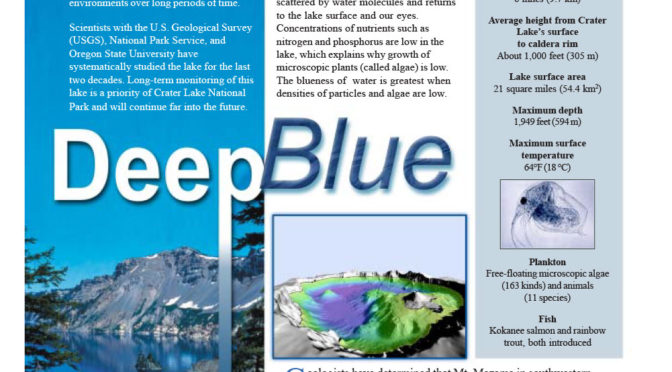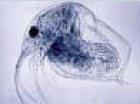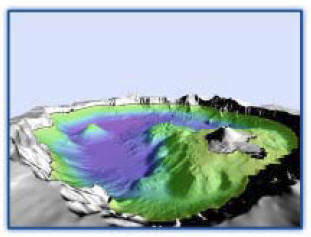Crater Lake | Blue Through Time
U.S. Geological Survey and the National Park Service Partnership in Monitoring
USGS Fact Sheet 018-03, March 2003
Crater Lake Blue Through Time as a complete pdf file:
Blue-through-time
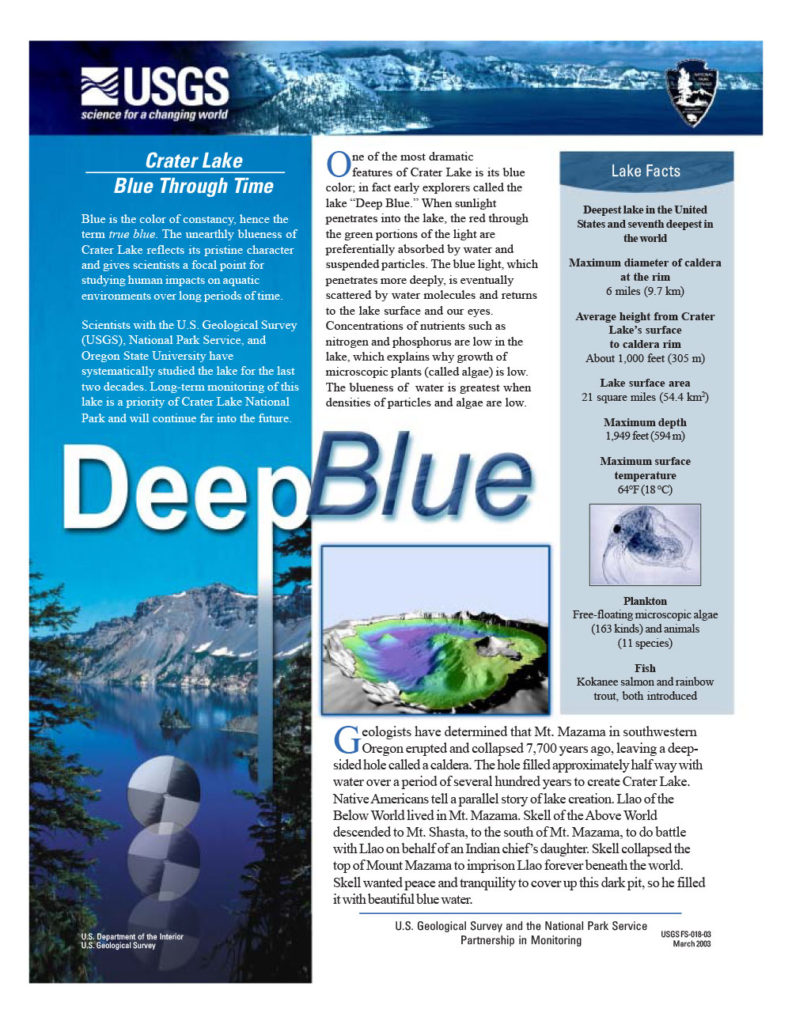
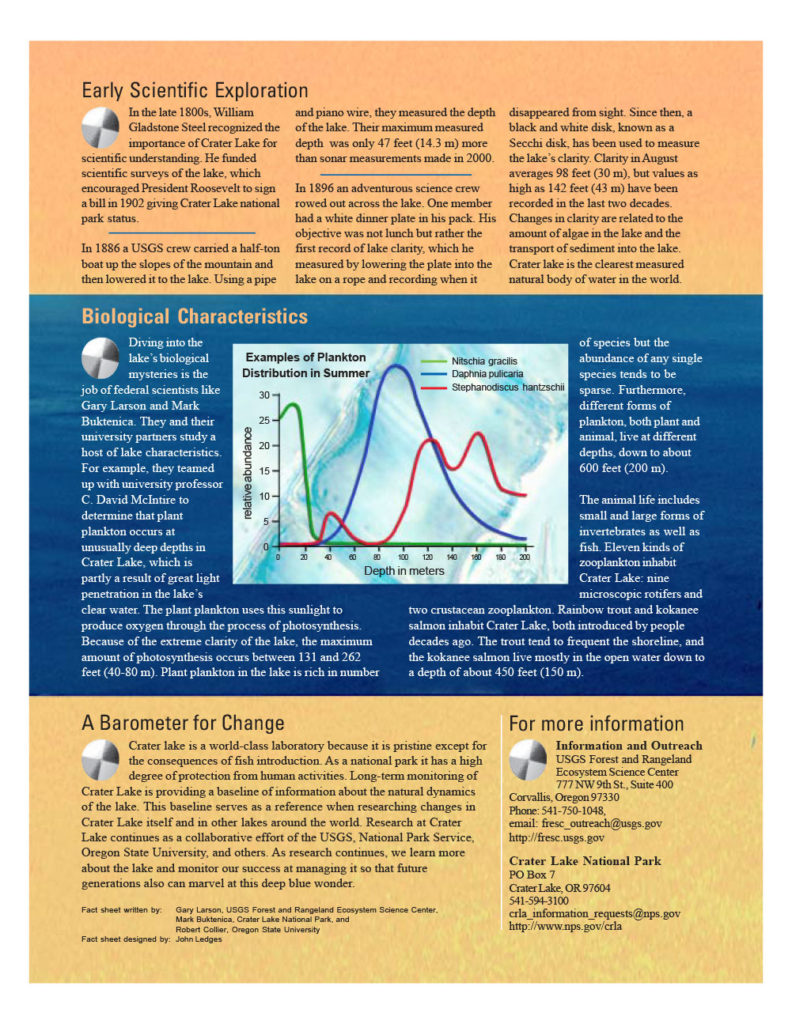
The text on both pages is below:
Blue is the color of constancy, hence the term true blue. The unearthly blueness of Crater Lake reflects its pristine character and gives scientists a focal point for studying human impacts on aquatic environments over long periods of time. Scientists with the U.S. Geological Survey (USGS), National Park Service, and Oregon State University have systematically studied the lake for the last two decades. Long-term monitoring of this lake is a priority of Crater Lake National Park and will continue far into the future.
|
Lake Facts Deepest lake in the United Maximum diameter of caldera Average height from Crater Lake surface area Maximum depth Maximum surface Plankton Free-floating microscopic algae Fish Kokanee salmon and rainbow |
One of the most dramatic features of Crater Lake is its blue color; in fact early explorers called the lake “Deep Blue.” When sunlight penetrates into the lake, the red through the green portions of the light are preferentially absorbed by water and suspended particles. The blue light, which penetrates more deeply, is eventually scattered by water molecules and returns to the lake surface and our eyes. Concentrations of nutrients such as nitrogen and phosphorus are low in the lake, which explains why growth of microscopic plants (called algae) is low. The blueness of water is greatest when densities of particles and algae are low.
Geologists have determined that Mt. Mazama in southwestern Oregon erupted and collapsed 7,700 years ago, leaving a deepsided hole called a caldera. The hole filled approximately half way with water over a period of several hundred years to create Crater Lake. Native Americans tell a parallel story of lake creation. Llao of the Below World lived in Mt. Mazama. Skell of the Above World descended to Mt. Shasta, to the south of Mt. Mazama, to do battle with Llao on behalf of an Indian chief’s daughter. Skell collapsed the top of Mount Mazama to imprison Llao forever beneath the world. Skell wanted peace and tranquility to cover up this dark pit, so he filled it with beautiful blue water.
Early Scientific Exploration
In the late 1800s, William Gladstone Steel recognized the importance of Crater Lake for scientific understanding. He funded scientific surveys of the lake, which encouraged President Roosevelt to sign a bill in 1902 giving Crater Lake national park status.
In 1886 a USGS crew carried a half-ton boat up the slopes of the mountain and then lowered it to the lake. Using a pipe and piano wire, they measured the depth of the lake. Their maximum measured depth was only 47 feet (14.3 m) more than sonar measurements made in 2000.
In 1896 an adventurous science crew rowed out across the lake. One member had a white dinner plate in his pack. His objective was not lunch but rather the first record of lake clarity, which he measured by lowering the plate into the lake on a rope and recording when it disappeared from sight. Since then, a black and white disk, known as a Secchi disk, has been used to measure the lake’s clarity. Clarity in August averages 98 feet (30 m), but values as high as 142 feet (43 m) have been recorded in the last two decades. Changes in clarity are related to the amount of algae in the lake and the transport of sediment into the lake. Crater lake is the clearest measured natural body of water in the world.
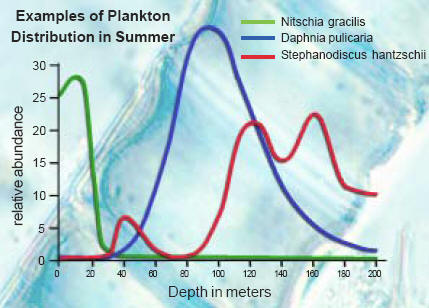 The animal life includes small and large forms of invertebrates as well as fish. Eleven kinds of zooplankton inhabit Crater Lake: nine microscopic rotifers and two crustacean zooplankton. Rainbow trout and kokanee salmon inhabit Crater Lake, both introduced by people decades ago. The trout tend to frequent the shoreline, and the kokanee salmon live mostly in the open water down to a depth of about 450 feet (150 m).Diving into the lake’s biological mysteries is the job of federal scientists like Gary Larson and Mark Buktenica. They and their university partners study a host of lake characteristics. For example, they teamed up with university professor C. David McIntire to determine that plant plankton occurs at unusually deep depths in Crater Lake, which is partly a result of great light penetration in the lake’s clear water. The plant plankton uses this sunlight to produce oxygen through the process of photosynthesis. Because of the extreme clarity of the lake, the maximum amount of photosynthesis occurs between 131 and 262 feet (40-80 m). Plant plankton in the lake is rich in number of species but the abundance of any single species tends to be sparse. Furthermore, different forms of plankton, both plant and animal, live at different depths, down to about 600 feet (200 m).
The animal life includes small and large forms of invertebrates as well as fish. Eleven kinds of zooplankton inhabit Crater Lake: nine microscopic rotifers and two crustacean zooplankton. Rainbow trout and kokanee salmon inhabit Crater Lake, both introduced by people decades ago. The trout tend to frequent the shoreline, and the kokanee salmon live mostly in the open water down to a depth of about 450 feet (150 m).Diving into the lake’s biological mysteries is the job of federal scientists like Gary Larson and Mark Buktenica. They and their university partners study a host of lake characteristics. For example, they teamed up with university professor C. David McIntire to determine that plant plankton occurs at unusually deep depths in Crater Lake, which is partly a result of great light penetration in the lake’s clear water. The plant plankton uses this sunlight to produce oxygen through the process of photosynthesis. Because of the extreme clarity of the lake, the maximum amount of photosynthesis occurs between 131 and 262 feet (40-80 m). Plant plankton in the lake is rich in number of species but the abundance of any single species tends to be sparse. Furthermore, different forms of plankton, both plant and animal, live at different depths, down to about 600 feet (200 m).
A barometer for Change
Crater lake is a world-class laboratory because it is pristine except for the consequences of fish introduction. As a national park it has a high degree of protection from human activities. Long-term monitoring of Crater Lake is providing a baseline of information about the natural dynamics of the lake. This baseline serves as a reference when researching changes in Crater Lake itself and in other lakes around the world. Research at Crater Lake continues as a collaborative effort of the USGS, National Park Service, Oregon State University, and others. As research continues, we learn more about the lake and monitor our success at managing it so that future generations also can marvel at this deep blue wonder.
Fact sheet written by: |
Gary Larson, USGS Forest and Rangeland Ecosystem Science Center, Mark Buktenica, Crater Lake NP, and Robert Collier, Oregon State University |
Fact sheet designed by: |
John Ledges |
For More Information
Information and Outreach
USGS Forest and Rangeland
Ecosystem Science Center
777 NW 9th St., Suite 400
Corvallis, Oregon 97330
Phone: 541-750-1048,
email: fresc_outreach@usgs.gov
http://fresc.usgs.gov
Crater Lake National Park
PO Box 7
Crater Lake, OR 97604
541-594-3100
crla_information_requests@nps.gov
http://www.nps.gov/crla
Other pages in this section
